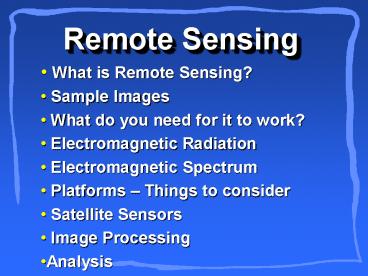Remote Sensing - PowerPoint PPT Presentation
1 / 24
Title:
Remote Sensing
Description:
Remote Sensing What is Remote Sensing? Sample Images What do you need for it to work? Electromagnetic Radiation Electromagnetic Spectrum Platforms Things to consider – PowerPoint PPT presentation
Number of Views:166
Avg rating:3.0/5.0
Title: Remote Sensing
1
Remote Sensing
- What is Remote Sensing?
- Sample Images
- What do you need for it to work?
- Electromagnetic Radiation
- Electromagnetic Spectrum
- Platforms Things to consider
- Satellite Sensors
- Image Processing
- Analysis
2
What is Remote Sensing?
- "Remote sensing is the science (and to some
extent, art) of acquiring information about the
Earth's surface without actually being in contact
with it. This is done by sensing and recording
reflected or emitted energy and processing,
analyzing, and applying that information."
(CCRS) - Aerial Photography A whole discipline on its
own - Satellite Imagery Includes information beyond
the visible spectrum. This is what we will focus
on.
3
This is a true color composite
4
This is a true color composite
5
This is a false color composite
6
This is a false color composite
7
Why the Strange Colors?
Stay tuned to find out!
8
How does it work?
- You need some sort of energy source Naturally,
this would be light from the sun. - You need a platform (satellite sensor) that
records the reflected electromagnetic radiation. - You need a computer that can process the
electronic information into an image. - You need a computer program and individual who
can interpret the images.
Read on to find out about how energy from the sun
works
9
Electromagnetic Radiation
This is the energy source provided by sun. This
is the first requirement for remote sensing to
work. Energy is emitted from the sun in the form
of electromagnetic radiation. Electromagnetic
radiation is emitted at various wavelengths.
Objects on the earth are sensitive to these
different wavelengths. We call this the
electromagnetic spectrum. See next slide..
10
Electromagnetic Spectrum
Below is a good picture of the electromagnetic
spectrum. You can see examples of objects
sensitive to different parts of the spectrum.
Notice, the visible part of the spectrum! This
is what we see. But look at all of the other
information we cannot see at different
wavelengths!
11
Electromagnetic Spectrum
Notice how small the visible part of the spectrum
is! This is the only part we can associate with
the concept of COLOUR. Everything else has no
colourassociated with it. There is a lot of
information at different wavelengths and
frequencies that we cannot see. This is where
remote sensing is so valuable.
Violet 0.4 - 0.446 mm Blue 0.446 - 0.500 mm
Green 0.500 - 0.578 mm Yellow 0.578 - 0.592
mm Orange 0.592 - 0.620 mm Red 0.620 - 0.7 mm
(Wavelength is measured in metres (m) or some
factor of metres such as nanometres (nm, 10-9
metres), micrometres (mm, 10-6 metres) (mm, 10-6
metres) or centimetres (cm, 10-2 metres). )
Short
Long
12
So What?.
The electromagnetic radiation hits the earths
surface. What happens to it when it hits? It can
do three things
Remote Sensing deals with the part that is
reflected How much of the electromagnetic
radiation is reflected in each wavelength? That
is the question
13
So What?.
Some things reflect more in parts of the
electromagnetic spectrum (or wavelength) then
other parts. We call this the objects spectral
signature.at what wavelength does it reflect
most? The more familiar you become with this,
the more easily you can interpret a remotely
sensed image..
14
Platforms
How do the various satellite platforms use this
information? Below are some satellites in the
sky right now. Each have different
characteristics in terms of spectral, spatial,
and temporal resolution.
- SPOT
- Landsat (TM)
- RadarSAT
- NOAA
- ERS
15
Spectral Resolution
- Satellites Image in multiple bands
16
Spatial Resolution
What size are the pixels? What is the smallest
object we can see?
17
Temporal Resolution
How many times does the satellite take an image
of the same area? Important for change
detection Dont forget the satellites orbit and
the earth orbits. SPOT 26 Days LANDSAT you
find out! RADAR you find out!
18
What do the satellites do?
Sensors record reflectance in each different
parts of the spectrum (band) at the same time. A
black and white image is created for each
bandvalues of 0-255 assigned. Whats the
problem? Technology cannot display all of this
information at once!
19
Image Processing
- Computers monitors can only display colours using
a combination of red, green and blue dots. - These dots of light originate from three Guns
at the back of the monitor.
These guns are called CHANNELS in the remote
sensing world.
So, we can only display 3 BANDS of information at
once by displaying them through the RED, GREEN,
or BLUE CHANNEL.
20
Image Processing
- The result is a funny looking colourful image
The more you know about the spectral signatures
of features, the more you will understand this
image.
21
Image Processing
Red
Green
Blue
For Display, 3 image layers shown at a time in R,
G, B
22
Analysis
- Band Combinations
True Colour images (land cover detection) Image
Red through Red Channel Image Green through Green
Channel Image Blue through Blue Channel
False Colour images (vegetation detection) Image
Infrared through Red Channel Image Red through
Green Channel Image Green through Blue Channel
23
Markets
24
Sources
- CCRS website
- Virtual Hawaii website
- ESRI Canada































